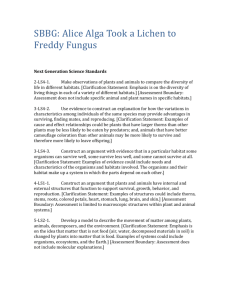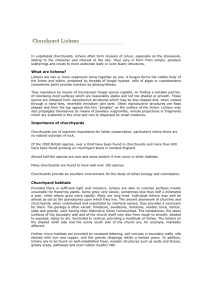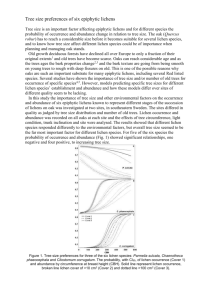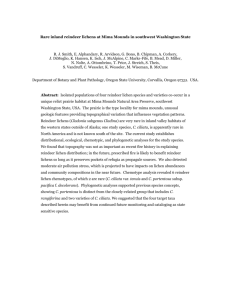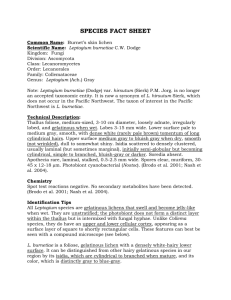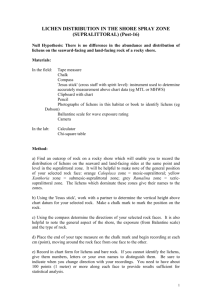Management Guidelines for Churchyards Lichens (MS Word Doc)
advertisement
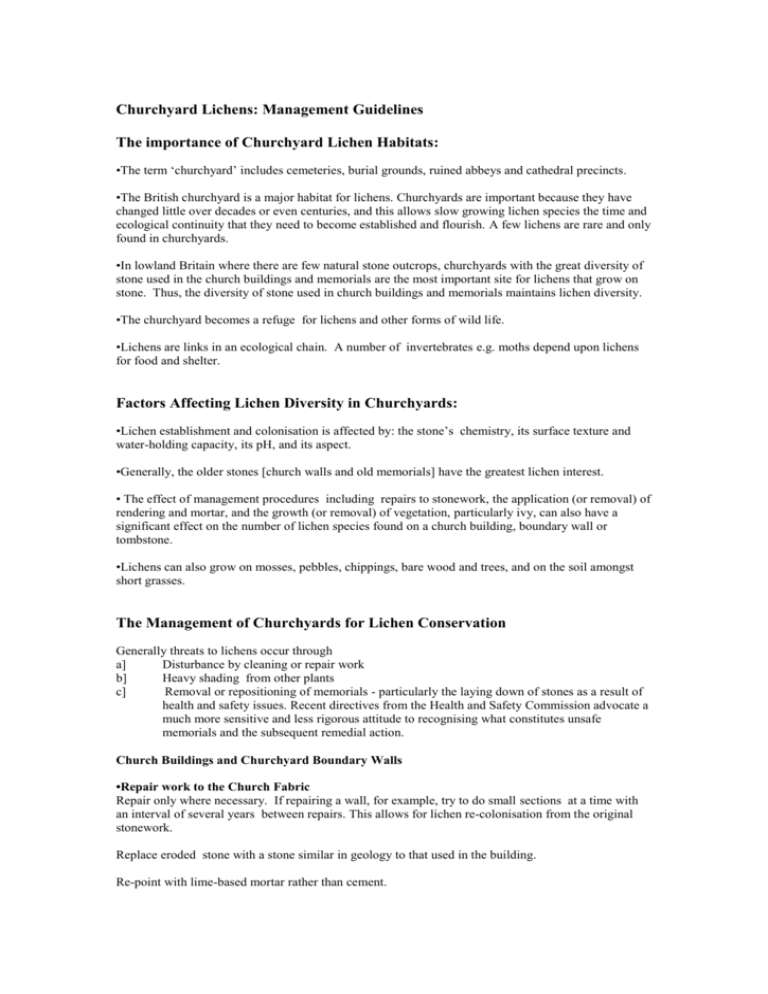
Churchyard Lichens: Management Guidelines The importance of Churchyard Lichen Habitats: •The term ‘churchyard’ includes cemeteries, burial grounds, ruined abbeys and cathedral precincts. •The British churchyard is a major habitat for lichens. Churchyards are important because they have changed little over decades or even centuries, and this allows slow growing lichen species the time and ecological continuity that they need to become established and flourish. A few lichens are rare and only found in churchyards. •In lowland Britain where there are few natural stone outcrops, churchyards with the great diversity of stone used in the church buildings and memorials are the most important site for lichens that grow on stone. Thus, the diversity of stone used in church buildings and memorials maintains lichen diversity. •The churchyard becomes a refuge for lichens and other forms of wild life. •Lichens are links in an ecological chain. A number of invertebrates e.g. moths depend upon lichens for food and shelter. Factors Affecting Lichen Diversity in Churchyards: •Lichen establishment and colonisation is affected by: the stone’s chemistry, its surface texture and water-holding capacity, its pH, and its aspect. •Generally, the older stones [church walls and old memorials] have the greatest lichen interest. • The effect of management procedures including repairs to stonework, the application (or removal) of rendering and mortar, and the growth (or removal) of vegetation, particularly ivy, can also have a significant effect on the number of lichen species found on a church building, boundary wall or tombstone. •Lichens can also grow on mosses, pebbles, chippings, bare wood and trees, and on the soil amongst short grasses. The Management of Churchyards for Lichen Conservation Generally threats to lichens occur through a] Disturbance by cleaning or repair work b] Heavy shading from other plants c] Removal or repositioning of memorials - particularly the laying down of stones as a result of health and safety issues. Recent directives from the Health and Safety Commission advocate a much more sensitive and less rigorous attitude to recognising what constitutes unsafe memorials and the subsequent remedial action. Church Buildings and Churchyard Boundary Walls •Repair work to the Church Fabric Repair only where necessary. If repairing a wall, for example, try to do small sections at a time with an interval of several years between repairs. This allows for lichen re-colonisation from the original stonework. Replace eroded stone with a stone similar in geology to that used in the building. Re-point with lime-based mortar rather than cement. Take particular care of areas of intact medieval stonework where significant lichen communities are often present. Those on the south and west walls of the church flourish in the unshaded conditions usually found there, whereas those on the north wall are adapted to damper and shadier conditions. Try not to alter these conditions. •Roofs Reuse original materials as far as possible and do not brush or clean tiles before re-positioning, or reverse natural slates. •Boundary Walls Reuse as much of the original material as possible. When rebuilding, retain the aspect of walling stones that noticeably support lichens, particularly south facing or capping stones. •Shading out Ivy and other plants climbing over the church and boundary walls smother the existing lichen flora and inhibit lichen establishment. They should be actively discouraged by cutting at the root and allowing the dead plant to fall away naturally. Physical removal may damage mortar and stone. Check regularly (at least once a year) for self-setting bramble, elder, ivy etc. Hand weed or, when necessary, spot treat with a herbicide. •Gravestones Lichens enhance the appearance of a stone adding a patina and appearance of antiquity. Variety in design and geology encourages species diversity. Ledgers and kerb surrounds to memorials, provide an important microhabitat for many species. Specific lichens prefer different niches. The aspect of a memorial is very important. If this is altered some lichen species will die. Removing or relocating a tombstone is to be avoided; where removal is unavoidable a lichenological survey should be undertaken first. Relocate stones to replicate the original aspect and light conditions. Leaning stones against a church or boundary wall kills the lichens on the memorial as well as those on the wall covered by the tombstone. Ancient chest tombs often have significant lichen communities particularly on the flat tops. Ivy and other vegetation should not be permitted to grow over them. The older stones often have the greatest lichen diversity. •Grassland Grass cuttings thrown onto horizontal slabs, low ledgers and kerbstones should be brushed off. If allowed to remain the cuttings will smother the lichens. Fertilisers and weedkillers alter the grassland ecology and will adversely affect those mosses, lichens and fungi that are only found in unimproved grasslands. Weedkillers should not be used around the base of a tombstone. They are absorbed upwards by the capillary effects of sedimentary stones, this damages the lichen flora and leaves an unsightly stain. •Trees If trees are planted, indigenous broad-leaved varieties are preferable. Select the planting site carefully, remembering that the root system and canopies of mature trees are extensive. Try to avoid shading the church wall – even the shade from rose bushes can have a detrimental effect, and also encourages damp to percolate the structure. •Lignum e.g. memorials, fences, seats etc Where lichen-rich fences have to be replaced, try to retain some old sections attached to the new wood by black plastic ties from which colonisation can progress to the new wood. Old lignum memorials (crosses etc) should be retained in the yard, preferably at the grave site. Do not paint or varnish seats.



